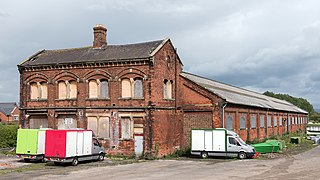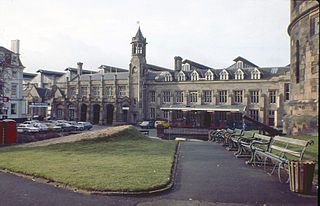Related Research Articles
The Maryport & Carlisle Railway (M&CR) was an English railway company formed in 1836 which built and operated a small but eventually highly profitable railway to connect Maryport and Carlisle in Cumberland, England. There were many small collieries in the area and efficient access to the harbour at Maryport was important.

The Lancaster and Carlisle Railway was a main line railway opened between those cities in 1846. With its Scottish counterpart, the Caledonian Railway, the Company launched the first continuous railway connection between the English railway network and the emerging network in central Scotland. The selection of its route was controversial, and strong arguments were put forward in favour of alternatives, in some cases avoiding the steep gradients, or connecting more population centres. Generating financial support for such a long railway was a challenge, and induced the engineer Joseph Locke to make a last-minute change to the route: in the interests of economy and speed of construction, he eliminated a summit tunnel at the expense of steeper gradients.

The Cumbrian Coast line is a rail route in North West England, running from Carlisle to Barrow-in-Furness via Workington and Whitehaven. The line forms part of Network Rail route NW 4033, which continues via Ulverston and Grange-over-Sands to Carnforth, where it connects with the West Coast Main Line.

Whitehaven railway station is a railway station serving the coastal town of Whitehaven in Cumbria, England. It is on the Cumbrian Coast Line, which runs between Carlisle and Barrow-in-Furness. It is owned by Network Rail and managed by Northern Trains.

Baggrow railway station was in the former county of Cumberland, now Cumbria, England. It was a stop on the Bolton Loop of the Maryport and Carlisle Railway.

The Border Union Railway was a railway line which connected places in the south of Scotland and Cumberland in England. It was authorised on 21 July 1859 and advertised as the Waverley Route by the promoters - the North British Railway. It connected the Edinburgh and Hawick Railway at Hawick with Carlisle.

The first Lancaster railway station was the northern terminus of the Lancaster and Preston Junction Railway, located in the Greaves area of the city of Lancaster, Lancashire, England. It was open from 1840 to 1849, by which time it had been superseded by Lancaster Castle railway station. Some books refer to the station as "Lancaster (Greaves)" or "Lancaster " to distinguish it from later stations in the city, although whilst open it was known simply as "Lancaster" as there was no other station of that name at the same time.

Brayton was a railway station which served as the interchange for the Solway Junction Railway (SJR) with the Maryport and Carlisle Railway (M&CR); it also served nearby Brayton Hall and district in Cumbria. The station was opened by the M&CR and became a junction station in 1870 on the 25 mile long SJR line.

Curthwaite was a railway station on the Maryport and Carlisle Railway (M&CR) serving West Curthwaite and Thursby in Cumbria. The station was opened by the M&CR in 1843 and lay in the Parish of Westward.

Dearham Bridge was a railway station on the Maryport and Carlisle Railway (M&CR) serving the village and rural district of Dearham in Cumberland, England. The station was opened by the M&CR in 1842 as Dearham, but was renamed Dearham Bridge in 1867 when the M&CR opened a station in the village of Dearham, to which it gave that name. Dearham Bridge station lay in the Parish of Crosscanonby.
Brookfield (Cumbria) railway station was a short-lived railway station that served Brookfield School, a Quaker school situated to the west of Wigton, England, for a few weeks in 1844–45.
Dovenby Lodge railway station was on the single track Derwent Branch of the Maryport and Carlisle Railway (M&CR) in the then county of Cumberland, now Cumbria, England.
Mealsgate railway station was in the former county of Cumberland, now Cumbria, England. It was a stop on the Bolton Loop of the Maryport and Carlisle Railway.
High Blaithwaite railway station was in the former county of Cumberland, now Cumbria, England. It was a stop on the Bolton Loop of the Maryport and Carlisle Railway.
Allhallows Colliery railway station was in the former county of Cumberland, now Cumbria, England. It was a stop on the Bolton Loop of the Maryport and Carlisle Railway.

Carlisle, in North West England, formed the focus for a number of railway routes because of the geography of the area. At first each railway company had its own passenger and goods station, but in 1847 passenger terminal facilities were concentrated at Citadel station, which is in use today. Goods facilities remained dispersed, and goods wagons passing through were remarshalled, incurring delay and expense.
Arkleby railway station was an early railway station on the Maryport and Carlisle Railway, in north-west England, close to the village of Arkleby in Cumbria, closing in 1852.
Carlisle Bogfield railway station, also known as Carlisle Water Lane railway station, served the city of Carlisle, in the historical county of Cumberland, England, from 1843 to 1844 on the Maryport and Carlisle Railway.
Milnthorpe railway station served the village of Milnthorpe, in the historical county of Westmorland, England, from 1846 to 1968 on the Lancaster and Carlisle Railway.
References
| Preceding station | Disused railways | Following station | ||
|---|---|---|---|---|
| Dalston Line closed, station open | Maryport and Carlisle Railway | Terminus |